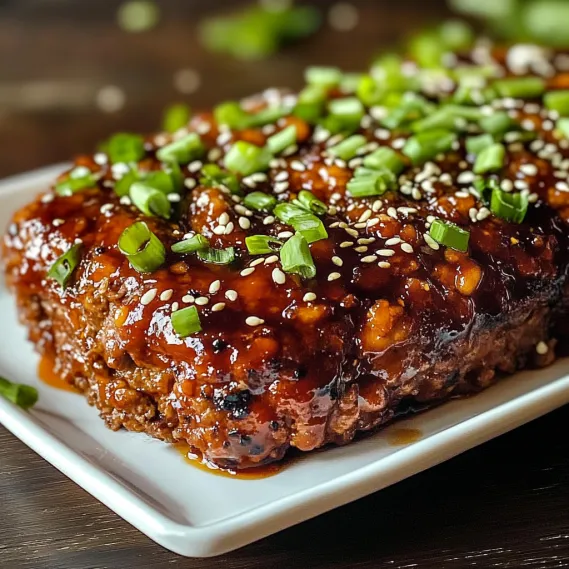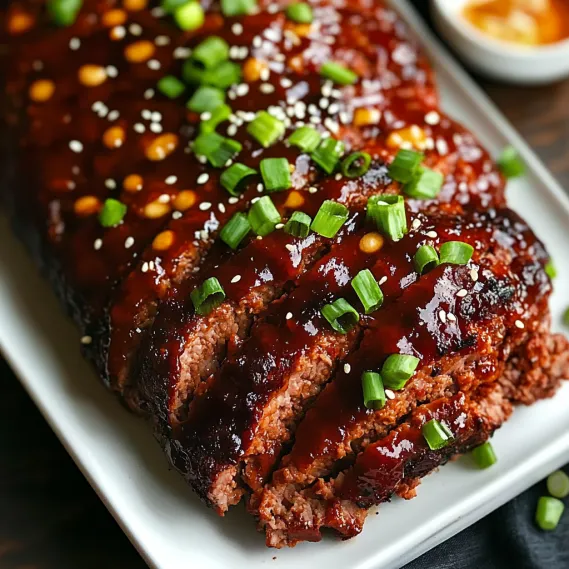 Pin
Pin
This sweet and spicy Korean BBQ meatloaf transforms the humble American classic into a flavor explosion that bridges two culinary worlds. The combination of gochujang, sesame oil, and brown sugar creates a depth of flavor that makes this dish utterly craveable and memorable for weeknight dinners or special occasions.
I first created this fusion meatloaf when trying to use up a tub of gochujang in my refrigerator, and it quickly became my husband's most requested dinner. The combination of familiar comfort food with Korean flavors makes this a perfect gateway dish for introducing new tastes to hesitant eaters.
Ingredients
- Ground beef: Preferably 80/20 lean to fat ratio for the juiciest result
- Sesame oil: Adds authentic Korean nutty flavor that transforms the dish
- Gochujang: Korean chili paste providing the perfect balance of spicy and sweet
- Brown sugar: Enhances caramelization and balances the heat
- Soy sauce: Adds umami depth and seasoning throughout
- Garlic and ginger: Fresh is best for brightest flavor
- Panko breadcrumbs: Lighter than traditional breadcrumbs for better texture
- Egg: Crucial binder that keeps everything together
- Rice vinegar: Adds brightness to cut through the richness
- Green onions and sesame seeds: For authentic garnish and texture
How To Make Sweet & Spicy Korean BBQ Meatloaf
- Preheat the Oven:
- Set your oven to 375°F. This moderate temperature allows the meatloaf to cook through without burning the sweet elements in the mixture. Take a moment to thoroughly grease your loaf pan to prevent sticking, as the sugars in this recipe can caramelize and adhere to the pan.
- Create the Meat Mixture:
- Combine all ingredients except the garnishes in a large bowl. Use your hands for the most effective mixing, but avoid overworking the meat which can make the final texture tough. You want everything evenly distributed but still loose in texture. The mixture will feel wetter than traditional meatloaf due to the liquid elements.
- Shape and Prepare:
- Transfer the mixture to your prepared loaf pan, gently pressing to eliminate air pockets without compacting the meat too firmly. Shape the top into a slight dome for even cooking. If making ahead, you can cover and refrigerate at this point for up to 24 hours.
- Baking Process:
- Bake uncovered for 40 minutes, then check the internal temperature. You're aiming for 155°F, as it will continue cooking slightly during rest time. The top should be developing a beautiful caramelized crust from the sugars in the mixture.
- Apply the Glaze:
- For an extra flavor boost, combine 1 tablespoon each of gochujang and honey with a splash of water to thin slightly. Brush this generously over the partially cooked meatloaf and return to the oven for the final 10 minutes of cooking. This creates a glossy, flavor packed exterior.
- Rest Before Serving:
- Allow the meatloaf to rest for a full 10 minutes before attempting to slice. This crucial step allows juices to redistribute throughout the meat, ensuring moist slices. Sprinkle with sliced green onions and sesame seeds just before serving for freshness and visual appeal.

The gochujang is truly the star ingredient in this recipe. I discovered its transformative powers years ago at a Korean cooking class, and now keep multiple varieties in my refrigerator at all times. My family particularly loves watching the glossy glaze develop in the final minutes of cooking – it signals that dinner magic is about to happen.
Storage and Reheating
This meatloaf actually improves in flavor after a day in the refrigerator, making it perfect for meal prep. Store leftover slices in an airtight container for up to 4 days. For best reheating results, place slices in a covered skillet with a tablespoon of water over medium low heat until warmed through, rather than using a microwave which can toughen the meat.
Perfect Pairings
While rice is the traditional accompaniment to Korean flavors, this meatloaf crosses cultural boundaries beautifully. Try serving with creamy mashed potatoes which provide the perfect canvas for soaking up the flavorful sauce. For a lighter option, steamed vegetables with a drizzle of sesame oil complement the flavors perfectly without competing with the star of the show.

Adjusting Spice Levels
The beauty of this recipe lies in its adaptability. For those sensitive to spice, start with just one tablespoon of gochujang and increase in future preparations as your palate adjusts. For heat lovers, add a teaspoon of gochugaru Korean chili flakes to intensify the spice profile. Remember that the spiciness will mellow slightly during cooking and when paired with side dishes.
Creative Leftovers
Transform leftover slices into Korean inspired sandwiches by placing them on toasted brioche buns with kimchi slaw. Another favorite in my household is chopping cold leftovers and crisping them in a hot skillet to create a hash topped with a fried egg for an unforgettable breakfast. The flavors become even more concentrated and delicious when reimagined this way.
Recipe FAQs
- → Can I reduce the spice level?
Yes, reduce the amount of gochujang for a milder flavor, or consider using a less spicy chili paste as a substitute.
- → What should I serve with this meatloaf?
Steamed white rice, roasted vegetables, or a crisp side salad pair wonderfully to complement the flavors.
- → Can I make this meatloaf ahead of time?
Absolutely! Prepare the meatloaf mixture in advance, refrigerate it, and bake when you’re ready. Leftovers can also be reheated easily.
- → How do I store leftovers?
Store leftover meatloaf in an airtight container in the refrigerator for up to 3 days. Reheat slices in the microwave or oven.
- → Can I use ground turkey instead of beef?
Yes, ground turkey works as a leaner option. However, the flavor and texture may vary slightly.
